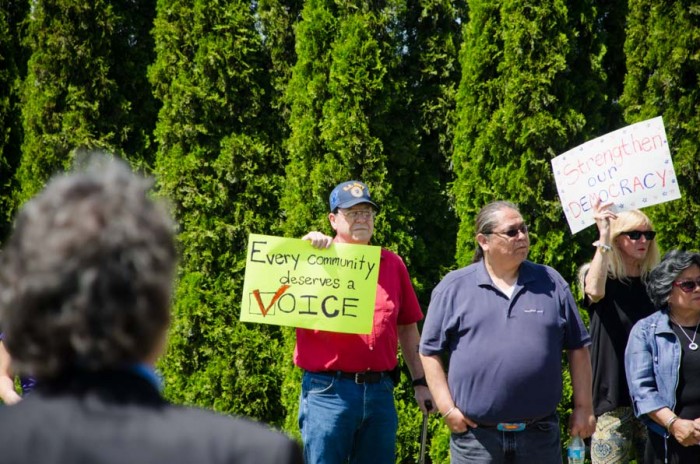
The Washington Voting Rights Act appears to have died in the legislature for the fourth straight year.
As late as Monday, Rep. Luis Moscoso, D-Mountlake Terrace, had hoped that this would be the year that the bill — which has passed from the Democratic-controlled state House for the past four sessions — would get to the Senate floor for a debate and vote. Last year, Yakima lost a federal court battle over whether its city council system suppressed representation of its significant Latino population.
While the Washington Voting Rights Act got further this year than in the past, it looks unlikely to reach the Senate floor.
Moscoso’s bill would have set up state procedures allowing communities of color that have not been able to get representation in elections to seek a district-based election system through the state courts and through means other than filing a federal complaint.
Currently, possible violations of the federal Voting Rights Act go through federal courts, as occurred last year in Yakima.
“This gives them a chance to avoid federal lawsuits,” Moscoso said.
But House Democrats and Senate Republicans could not reach a compromise on the bill because the GOP did not want to allow the state courts to be a venue for the Voting Rights Act, said Senate Majority Leader Mark Schoesler, R-Ritzville.
The GOP’s biggest sticking point is the concern that the bill would lead to an increase — and not a decrease — in lawsuits against cities, counties and school districts from communities seeking more representation, Schoesler said.
Schoesler also said the Association of Washington Cities and the Washington State Association of Cities and Counties opposed the bill because of a fear of lawsuits.
Yakima’s former mayor and its current council both backed the state Voting Rights Act bill.
Moscoso said the GOP fears about an increase in lawsuits because of the bill are unfounded because lawsuits can be filed now in federal court. The Washington House passed the Voting Rights Act this year by a 50-47 party line split.
The state’s Voting Rights Act would have set up ground rules in which communities of color that are underrepresented on their local elected boards and councils could seek better representation, by allowing municipalities to switch from an at-large system of electing officials to a district system.
Under an at-large city council elections system, a majority population can dilute minority votes, resulting in a system that does not allow for equal representation. Under a geographic city council district system, the votes of people of color could be less likely to be diluted by a city-wide majority. The federal Voting Rights Act also calls for avoidance of gerrymandering — attempts to dilute the representation of communities of color by squeezing minority populations into certain districts.
At-large city elections are sometimes seen as a reason that a white majority can elect all-white governing bodies despite significant non-white populations.
Adopting city council districts appears to address that issue. For instance, under the new district system for Yakima’s council that was imposed last year after the federal lawsuit, voters elected three Latinas — the first Hispanics ever elected — to the council. One of those council members was promoted to mayor, the city’s first Latina mayor.
Seattle also boosted diversity on its city council after switching to a new geographic council district system last year that was approved by voters, and also elected its first Latina council members. However, in Seattle’s case, proponents of that ballot measure cited improved neighborhood representation on the council, rather than racial or ethnic representation.
The seattlepi.com website recently reported that throughout the state, 6.4 percent of school board members and 7 percent of city council members are people of color. That falls behind the almost one-third of Washingtonians and 40 percent of the state’s students who are people of color, according to the Washington Community Action Network.
Editor’s note: This article has been changed to reflect that it was Schoesler who mentioned the concerns by the Association of Washington Cities and the Washington State Association of Cities and Counties.

